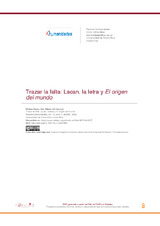Mostrar el registro sencillo del ítem
Trazar la falta: Lacan, la letra y El origen del mundo
| dc.contributor.author | Molina Barea, María del Carmen | |
| dc.date.accessioned | 2022-11-11T12:22:48Z | |
| dc.date.available | 2022-11-11T12:22:48Z | |
| dc.date.issued | 2022 | |
| dc.identifier.uri | http://hdl.handle.net/10396/24325 | |
| dc.description.abstract | El presente artículo hilvana un recorrido creativo por la teoría del sujeto de la diferencia sexual de Jacques Lacan, desde un ángulo heterodoxo y polivalente, buscando afinar una propuesta crítica que facilite una alternativa concreta a la tesis lacaniana que afirma que la mujer no existe. Persiguiendo este objetivo, el artículo reivindica la noción de deseo inconsciente y acude metodológicamente a Gilles Deleuze y Félix Guattari, y Luce Irigaray. Asimismo, redefine el valor de la letra como trazo de goce, subvirtiendo el potencial de la caligrafía china y japonesa que analiza Lacan. Para ello, se toman como casos de estudio al pintor taoísta Shitao, las semiografías de André Masson y el cuadro El origen del mundo de Gustave Courbet, que fue propiedad de Lacan. El aspecto central del artículo consiste en evidenciar que el significante simbólico, denominado Falo o Nombre del Padre, indica la falta esencial de la castración, que regula la producción identitaria del Otro y excluye a la mujer del lenguaje y la representación. | es_ES |
| dc.description.abstract | The present paper provides creative insight into Jacques Lacan’s theoretical understanding of sexual difference from an unconventional perspective, in the attempt to develop a critical approach as well as a concrete alternative to the Lacanian declaration the woman does not exist. To this end, this paper revisits the notion of unconscious desire, methodologically inspired by Gilles Deleuze and Felix Guattari and Luce Irigaray. In this line, it will also redefine the power of the letter as trace’s enjoyment, thus subverting the potential of Chinese and Japanese calligraphy analyzed by Lacan. With this aim, certain cases studies will be of use, such as the Taoist painter Shitao, the semiographies painted by André Masson, and The Origin of the World, the painting by Gustave Courbet which was owned by Lacan himself. The crucial aspect is ultimately to locate lack as the essential product of castration within the symbolic signifier -also knowned as Phallus and the Name of the Father- which rules the Other’s production of subjectivity, excluding women from language and representation. | es_ES |
| dc.format.mimetype | application/pdf | es_ES |
| dc.language.iso | spa | es_ES |
| dc.publisher | Universidad de Costa Rica | es_ES |
| dc.rights | https://creativecommons.org/licenses/by-nc-nd/3.0/ | es_ES |
| dc.source | Revista Humanidades, 12(2), e50957 (2022) | es_ES |
| dc.subject | Psicoanálisis | es_ES |
| dc.subject | Semiología | es_ES |
| dc.subject | Caligrafía | es_ES |
| dc.subject | Pintura | es_ES |
| dc.subject | Psychoanalysis | es_ES |
| dc.subject | Semiotics | es_ES |
| dc.subject | Calligraphy | es_ES |
| dc.subject | Painting | es_ES |
| dc.title | Trazar la falta: Lacan, la letra y El origen del mundo | es_ES |
| dc.title.alternative | Tracing Lack: Lacan, the Letter and The Origin of the World | es_ES |
| dc.type | info:eu-repo/semantics/article | es_ES |
| dc.relation.publisherversion | https://doi.org/10.15517/h.v12i2.50957 | es_ES |
| dc.rights.accessRights | info:eu-repo/semantics/openAccess | es_ES |

